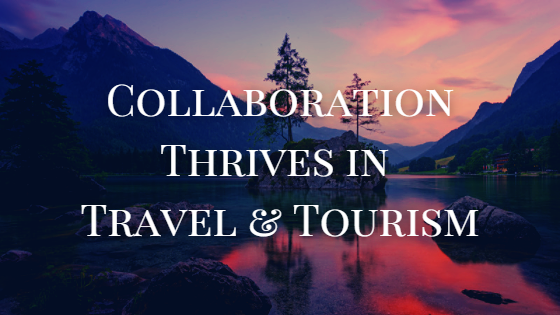Collaboration Thrives in Travel & Tourism
The travel and tourism industry was indisputably one of the hardest hit during the past two years. Staying in business meant being innovative, flexible and responsive to change. To be successful, it also meant a willingness to collaborate, sometimes with a perceived competitor. Connecting and embracing collaboration with others in the industry, despite being in lockdown, ultimately allowed many travel professionals to stay afloat during the most challenging of times.
Blending knowledge, experiences, and sometimes budgets, can result in outcomes that far exceed the results from working in silos. The travel, tourism and hospitality industry may still have years before returning to its pre-pandemic level of travel. But these travel professionals have used innovative collaboration models to propel them forward during recovery.

Making Industry Connections
Travel Alliance Partners, LLC (TAP) is in its 21st year of connecting tour operators, destinations, attractions and corporate service providers. During a time of economic decline, founder Serge Talbot, President of Talbot Tours, recognized the need for tour operators to collaborate. Putting aside the natural competitiveness among companies, TAP developed a model with tour operators buying and selling from one another. This created significant buying power as a company. A buying power of a combined $75 million in annual sales. This buying power then led to discount and rebate agreements with hotels, insurance providers, cruise lines and more. The competitors not only grew their own businesses, but, reaped rewards with additional revenue in the form of rebates.
New collaboration opportunities developed as the TAP tour operators elevated the value of suppliers to their success. Recognizing suppliers (destinations and attractions) as integral to creating inspiring itineraries, TAP created an annual travel conference called TAP Dance. This innovative conference brought new travel ideas to the tour operators and resulted in more visitors to the destinations. It solidified the TAP collaboration model emphasizing the importance of these relationships. Now you can even catch suppliers and TAP Tour Operators hosting TAP travel webinars together.
The next obvious collaboration for TAP was with travel buyers. TAP developed a program where travel buyers from across the country could sell TAP travel product on their own website; ultimately giving the travel buyer the opportunity to expand their own product portfolio.
The TAP model of collaboration helped tour operators, suppliers and travel buyers weather the pandemic and prepare them for pent-up demand.
Local Communities Collaborate
Traditionally, tourism entities and community economic development organizations have existed in silos. Exceptions to that are becoming more prevalent as more people recognize the value of collaboration. Annette Rummel, CEO at Great Lakes Bay Regional Convention & Visitors Bureau, is a master at building partnerships. Annette recognized the value in collaboration and with her colleagues created the Great Lakes Bay Regional Convention and Visitors Bureau from three county CVBs. Along with that, she created a model detailing how her regional CVB aligns with the regional chamber of commerce. Each of the regional CVBs still maintains control over tourism development while the regional CVB focuses on marketing initiatives. This approach resulted in each county saving 85% in overhead costs. Annette’s key advice for those interested in collaboration: be proactive; don’t wait for invitations.
Dynamic Destinations Collaborate
One of the key criteria for identifying a successful collaboration is typically commonality. Todd Stallbaumer, Consumer and Trade Marketing Direction for Oklahoma Tourism & Recreation Department, participates in a collaborative group. He and several industry colleagues call their group Dynamic Destinations. These creative travel professionals collaborate based on commonality in the usual areas that come to mind with tourism. It formed from an unlikely grouping of DMOs and attractions at the onset of the pandemic. This group met daily on Zoom to stay connected, share challenges and collaborate on working through ideas and developing solutions.
This group of about six remain and have now attended travel shows together as an entity, cross-marketing one other. They have found a way to complement their competition. By identifying ways these Dynamic Destinations are different and stand out; and not necessarily better, they create a different experience. These six destinations would traditionally not have tours that would include one another in one trip. They’ve found that if they can get a visitor to any of the destinations, they can refer them to one of the other five for these common factors:
- They are close to a bigger competitor or name geographically. For example, the proximity of Maryland to Washington, D.C.
- The destination is often a value-added destination to a larger attraction or city.
- In all cases, traveler feedback for these destinations is that the experience far exceeds the expectations.
They hold group virtual sales calls using the rationale that some areas may have better partnerships with certain tour companies. All six participate on the call to talk about their destinations. They found that tour planners love getting ideas for six diverse destinations in just 30 minutes.
Tips for Successful Collaborations:
- Leave egos out of the group
- Establish expectations up-front
- Be proactive in seeking collaboration partners, don’t wait to be invited
- Identify a communication strategy that is effective for all involved
- Look for connection beyond the obvious commonality
Get more tips for successful collaborations when you take this 1-question quiz.
Author
Related Posts
Collaboration Drives Sustainable Tourism
Sustainable tourism has growing importance in the world of travel and tourism. As destinations grow in popularity, they need to collaborate closely with residents, local…
Marketing for Group Travel: Building Solid Relationships with Tour Operators
Group travel is a significant segment of the tourism market, and if you want to see those buses pulling up to the curb and filling…
